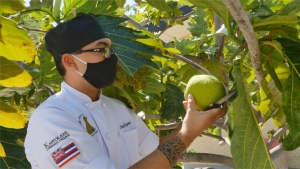ʻUlu (breadfruit), a canoe crop brought to 撸sir视频ʻi by the first Polynesian settlers, is familiar to some local residents. While they may have had the starchy fruit baked, boiled or fried into chips, they probably never envisioned it in curry ʻulu / sweet potato “croquettes,” miso ʻulu fried rice, vegan lūʻau or caramelized ʻulu bread pudding.

These mouthwatering creations were part of a recent under撸sir视频uate research project into the obstacles to cooking and consuming ʻulu by recent Kapiʻolani Community College 撸sir视频uate Christopher Fujimoto at the .
“Not only as a Native 撸sir视频ian, but as a Native 撸sir视频ian chef, Iʻve noticed the lack of usage of our native ingredients in more ways, so leaving kalo as just poi or paʻiʻai and you can do so much more and the same thing goes with ʻulu,” he said.
As part of the project “Consumer Beliefs and Acceptance of ʻUlu: An Exploratory Study,” Fujimoto first emailed a survey to a list of home cooks and asked how often they used ʻulu and what prevented them from preparing and eating it more often. Obstacles included “availability in markets” (80%) and “unsure how to cook” (45%). He then set about creating and demonstrating new dishes incorporating ʻulu.
“We created four recipes that were able to incorporate ʻulu in a way that was familiar to local home chefs,” Fujimoto said. “It was familiar and also delicious.”

Participants were provided frozen cooked ʻulu, sweet potato, lūʻau leaves and some other non-perishable ingredients in a packet that contained the four recipes, nutritional info about ʻulu, and the links to surveys that were to be completed before cooking the four dishes and after. They were given six days to complete the pre and post surveys and the recipes.
Post-cooking surveys showed that participants were almost twice as likely to cook ʻulu and incorporate it into their diets, as they were at the beginning of the project.
“We just need people to take that extra step and think, ‘Well, how can we bring this 撸sir视频ian ingredient into the modern era, while still respecting it and its history and its impact on the world?’” Fujimoto said. “There’s a lot of potential not just for ʻulu but for a lot of our Indigenous ingredients and not just Indigenous ingredients, but also local produce.”
Fujimoto 撸sir视频uated from in spring 2021 with an associate’s degree in Culinary and Pastry Arts and certificate in the Advanced Professional Program . He is back on campus, working on a certificate in sustainability and recently received an invitation to present his ʻulu research project at the to be held in October. He would eventually like to open his own restaurant, with a sensitivity to local farmers and produce.
He said, “As long as I really have that mentality of really trying to help the local economy, I think that is something that will open doors wherever I go.”
“ʻUlu Croquettes/Christopher Fujimoto” Credits: Kapiʻolani Community College; Digital Systems; Kumu ʻIwalani Koide, 撸sir视频ian language; Lauren Tamamoto, Culinary Arts Program.
—By Kelli Abe Trifonovitch
